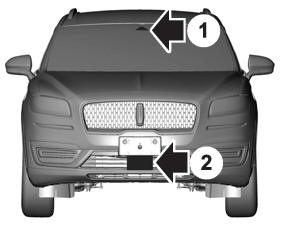Lincoln Nautilus: Exterior Lighting / Headlamp Control Module (HCM). Removal and Installation
Removal
NOTE: Removal steps in this procedure may contain installation details.
-
NOTE: This step is only necessary if the HCM is being replaced.
NOTE: If installing a new module, it is necessary to upload the module configuration information to the scan tool prior to removing the module. This information must be downloaded into the new module after installation.
NOTE: If the HCM did not respond to the diagnostic scan tool, As-Built Data may need to be entered as part of the repair.
Using a diagnostic scan tool, begin the PMI process for the HCM following the on-screen instructions.
-
Remove the push pins, disconnect the electrical connector and remove the RH dash insulator panel.
.jpg) |
-
Remove the headlamp control module.
-
Remove the headlamp control module bracket bolts and the headlamp control module.
Torque: 80 lb.in (9 Nm)
-
Disconnect the headlamp control module electrical connector.
-
Remove the headlamp control module bracket bolts and the headlamp control module.
.jpg) |
Installation
-
To install, reverse the removal procedure.
-
Using a diagnostic scan tool, complete the PMI process for the HCM following the on-screen instructions.
 Headlamp Bulb. Removal and Installation
Headlamp Bulb. Removal and Installation
Removal
Remove the headlamp assembly.
Refer to: Headlamp Assembly (417-01 Exterior Lighting, Removal and Installation).
Remove the screws and position the ballast...
 Headlamp Leveling Module. Removal and Installation
Headlamp Leveling Module. Removal and Installation
Removal
NOTE:
Removal steps in this procedure may contain installation details.
NOTE:
If installing a new module, it is necessary to
upload the module configuration information to the scan tool prior to
removing the module...
Other information:
Lincoln Nautilus 2018-2025 Service Manual: Alternating Current (AC) Power Outlet Socket. Removal and Installation
Removal WARNING: Disconnect the 12 volt battery before servicing the direct current to alternating current (DC-AC) inverter or alternating current (AC) powerpoint to prevent the risk of high voltage shock. Failure to follow this instruction may result in serious personal injury...
Lincoln Nautilus 2018-2025 Owners Manual: How Does Stability Control Work
WARNING: Vehicle modifications involving braking system, aftermarket roof racks, suspension, steering system, tire construction and wheel and tire size may change the handling characteristics of your vehicle and may adversely affect the performance of the electronic stability control system...
Categories
- Manuals Home
- 1st Generation Nautilus Owners Manual
- 1st Generation Nautilus Service Manual
- Drive Mode Control
- Engine Oil Capacity and Specification - 2.0L
- Anti-Theft Alarm System Settings. Security – Troubleshooting
- New on site
- Most important about car
Locating the Pre-Collision Assist Sensors

If a message regarding a blocked sensor or camera appears in the information display, something is obstructing the radar signals or camera images. The radar sensor is behind the fascia cover in the center of the lower grille. With a blocked sensor or camera, the system may not function, or performance may reduce. See Pre-Collision Assist – Information Messages.
